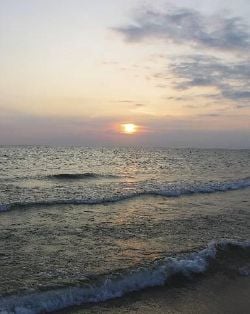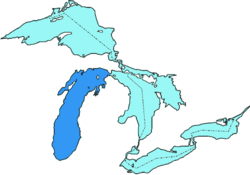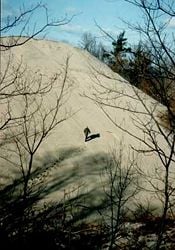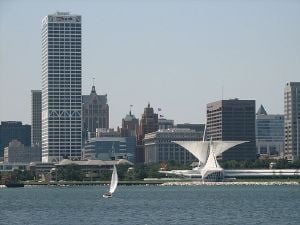Difference between revisions of "Lake Michigan" - New World Encyclopedia
({{Contracted}}) |
Rosie Tanabe (talk | contribs) |
||
| (25 intermediate revisions by 7 users not shown) | |||
| Line 1: | Line 1: | ||
| − | {{ | + | {{Copyedited}}{{Approved}}{{Submitted}}{{Images OK}}{{Paid}} |
{{Infobox_lake |lake_name = Lake Michigan | {{Infobox_lake |lake_name = Lake Michigan | ||
|image_lake = LightningVolt Lake Michigan Sunset.jpg | |image_lake = LightningVolt Lake Michigan Sunset.jpg | ||
| Line 5: | Line 5: | ||
|image_bathymetry = | |image_bathymetry = | ||
|caption_bathymetry = | |caption_bathymetry = | ||
| − | |coords = {{ | + | |coords = {{coord|43|30|N|87|30|W|type:waterbody_region:US}} |
|type = | |type = | ||
|inflow = | |inflow = | ||
| Line 13: | Line 13: | ||
|length = 307 miles (494 km) | |length = 307 miles (494 km) | ||
|width = 118 miles (190 km) | |width = 118 miles (190 km) | ||
| − | |area = 22,400 square miles (58,016 km²)<ref name=nyt> | + | |area = 22,400 square miles (58,016 km²) <ref name=nyt>John W. Wright, (ed.), ''The New York Times Almanac'' (New York: Penguin Books, 2004, ISBN 0143038206).</ref> |
|average depth = 279 feet (85 m) | |average depth = 279 feet (85 m) | ||
|max-depth = 923 feet (282 m)<ref name=nyt/> | |max-depth = 923 feet (282 m)<ref name=nyt/> | ||
| Line 21: | Line 21: | ||
|elevation = 577 feet (176 m)<ref name=nyt/> | |elevation = 577 feet (176 m)<ref name=nyt/> | ||
|islands = ''see [[#Islands|list]]'' | |islands = ''see [[#Islands|list]]'' | ||
| − | |cities = [[Milwaukee, Wisconsin|Milwaukee]]<br>[[Chicago]]<br>See article for others. | + | |cities = [[Milwaukee, Wisconsin|Milwaukee]]<br/>[[Chicago]]<br/>See article for others. |
}} | }} | ||
| − | |||
| + | '''Lake Michigan''' is one of the five [[Great Lakes]] of [[North America]], and the only one in the group located entirely within the [[United States]]. It is bounded, from west to east, by the [[U.S. state]]s of [[Wisconsin]], [[Illinois]], [[Indiana]], and [[Michigan]]. Lake Michigan is hydrologically inseparable from [[Lake Huron]], joined by the wide [[Straits of Mackinac]]. | ||
| + | |||
| + | More than 12 million people live along Lake Michigan's shores. The great cities of [[Chicago]] and [[Milwaukee]] were settled and grew because of their locations on the lake. The southern tip of the lake is heavily [[industry|industrialized]]. The beaches of Lake Michigan, especially those in [[Michigan]] and northern [[Indiana]], are known for their beauty, earning the region the nickname the "Third Coast" of the United States after those of the [[Atlantic Ocean|Atlantic]] and the [[Pacific Ocean|Pacific]] oceans. | ||
| + | {{toc}} | ||
| + | The word "Michigan" was originally used to refer to the [[lake]] itself, and is believed to come from the [[Ojibwe language|Ojibwa]] Indian word ''mishigami'', meaning "great water." The lake is slightly larger than the nation of [[Croatia]]. | ||
| + | [[Image:Great Lakes Lake Michigan.png|thumb|250px|Lake Michigan and the other Great Lakes]] | ||
== History == | == History == | ||
| − | + | Clovis Point remnants are evidence of the earliest inhabitants of the Lake Michigan region; the Old Copper Culture peoples left traces of their advanced coomunities from the [[copper]] pit mines of northern [[Lake Superior]] to the ancient [[fores]]ts now deep under the water of southern Lake Michigan. Up until about 1500 B.C.E. the landscape differed in other ways as well; the present-day Straits of Mackinac was a 300 foot (1000 m) deep riverine canyon. | |
| + | The Woodland People who gradually claimed the region from the Old Copper Culture were [[agriculture|agriculturalists]] who were widely dispersed throughout the area of the [[Great Lakes]]. These were the people, in the process of joining with the vast [[Iroquois|Iroquois Nation]], who were encountered by the first [[Europe]]an explorers in 1615. | ||
| + | |||
| + | [[Jean Nicollet]], under orders from [[Samuel de Champlain]], has been credited as being the first European to travel into Lake Michigan, sailing around Manitoulin Island to enter Lake Michigan through the Mackinac Straits, in search of the fabled Northwest Passage.<ref> [https://www.historymuseum.ca/virtual-museum-of-new-france/the-explorers/jean-nicollet-1634/ The Explorers: Jean Nicollet 1634] ''Canadian Museum of History''. Retrieved January 24, 2020.</ref> | ||
| + | |||
| + | The Jesuit Claude-Jean Allouez began missionary work among the Indians of Green Bay and the Fox River in 1668. The French missionary/explorer team of [[Jacques Marquette|Marquette]] and [[Louis Jolliet|Jolliet]] mapped the lake's western shore from Green Bay to Chicago in 1673. | ||
| + | |||
| + | The first sailing ship was brought to the Lake in 1679 by Robert Cavelier, but was lost in a storm on its return east with a cargo of furs. Robert de La Salle eventually established a trading post near St. Joseph, Michigan. | ||
==Geography== | ==Geography== | ||
| − | + | {{readout||left|250px|Lake Michigan is the only one of the North American [[Great Lakes]] wholly within the borders of the [[United States]]}} | |
| − | Lake Michigan (43°30'N, 87°30'W) is the only one of the [[Great Lakes]] wholly within the borders of the [[United States]]; the others are shared with [[Canada]]. It has a surface area of 22,400 square miles (58,016 km²)<ref name=nyt/> | + | Lake Michigan (43°30'N, 87°30'W) is the only one of the [[Great Lakes]] wholly within the borders of the [[United States]]; the others are shared with [[Canada]]. It has a surface area of 22,400 square miles (58,016 km²),<ref name=nyt/> making it the largest freshwater lake in the U.S., the largest lake entirely within one country, and the fifth largest lake in the world. It is 307 miles (494 km) long by 118 miles (190 km) wide with a shoreline 1,640 miles (2,633 km) long. The lake's average depth is 279 feet (85 m), while its greatest depth is 923 feet (281 m).<ref name=nyt/> It contains a volume of 1,180 cubic miles (4,918 cubic km) of water. Its surface averages 577 feet (176 m)<ref name=nyt/> above sea level, the same as [[Lake Huron]], to which it is connected through the [[Straits of Mackinac]]. |
| + | |||
| + | ===Beaches=== | ||
| + | [[Image:Lake michigan 1925.jpg|thumb|250px|left|Crowd of bathers on the Lake Michigan beach, [[Chicago]] around 1925.]] | ||
| + | Lake Michigan beaches, especially those beaches in [[Michigan]] and Northern [[Indiana]], are known for their beauty and the region is often referred to as the "Third Coast" of the United States after those of the [[Atlantic Ocean|Atlantic]] and the [[Pacific Ocean|Pacific]] oceans. | ||
| + | |||
| + | The sand is soft and off-white, known as "singing sands" because of the squeaking noise made when one walks across it, caused by its high [[quartz]] content. There are often high sand dunes covered in green [[beach grass]] and [[sand cherries]], and the water is usually clear and cold (between 55 and 70 °F/13 and 21 °C) even in late summer.<ref> [http://www.coastwatch.msu.edu/twomichigans.html Lake Michigan] ''Michigan Sea Grant''. Retrieved January 24, 2020.</ref> Lake Michigan beaches in northern Michigan are the only place in the world where one can find [[Petoskey stone]]s, the state stone, aside from a few inland lakes in that region. | ||
| + | |||
| + | The beaches of the western coast and the northernmost part of the east coast are rocky while the southern and eastern beaches are sandy and dune covered. This is partly because of the prevailing winds from the west which also cause thick layers of ice to build up on the eastern shore in winter. | ||
| + | |||
| + | [[Chicago]] annually imports fresh sand to replenish the popular city beaches but much of the city waterfront is covered by seawalls, harbors or developments. | ||
| + | |||
| + | Steel mills are visible along the [[Indiana]] shoreline, and the [[pollution]] caused by these mills is believed to contribute to the color of sunsets. | ||
| − | ===Major cities== | + | The Chicago [[skyline]] can be seen from the Indiana shore, but when standing on the beaches in [[Wisconsin]] or Lower Michigan, it is impossible to see across the lake, providing a view similar to that found on ocean coasts. |
| − | Some 12 million people live along Lake Michigan's shores. Many small cities in | + | |
| + | ==Geology== | ||
| + | Geologically and hydrologically, Michigan and Huron are the same body of water (sometimes called Lake Michigan-Huron), but are geographically distinct. Counted together, it is the largest fresh water body in the world by surface area. The Mackinac Bridge is generally considered the dividing line between them. Both lakes are part of the [[Great Lakes Waterway]]. In earlier maps of the region, the name "Lake Illinois" has been found in place of "Lake Michigan." | ||
| + | |||
| + | ==Ecology== | ||
| + | [[Image:Indiana dunes.jpg|thumb|right|175px|[[Sand dune]] on Lake Michigan at [[Indiana Dunes National Lakeshore]].]] | ||
| + | The dunes along the southern shoreline of Lake Michigan are the largest lake dunes in the world. Originally marking the ancient terminal reaches of the ice age lake, the dunes are fed by southward currents robbing the northwestern shoreline. The [[Indiana Dunes]] complex is a remarkable ecological preserve of the beech-maple climax community. The modern study of [[ecology]] was devised through the study of the Dunes by Henry C. Cowles of the [[University of Chicago]]. His exacting longitudinal observation of the dunes' plant communities led to a new understanding of the progression and interaction of [[plant]]s and the environment over time. As dune grasses stabilized the dune, allowing for a steady build-up of organic material, larger plants could survive and thrive, eventually resulting in the [[forest]] complex anchoring the oldest of the dunes.<ref>[http://www.lib.uchicago.edu/projects/centcat/centcats/fac/facch14_01.html Henry C. Cowles; Botany] ''The University of Chicago Faculty: A Centennial View''. Retrieved January 24, 2020.</ref> | ||
| + | |||
| + | The Indiana Dunes, and the dunes of the eastern shore of Lake Michigan, notably the Sleeping Bear Dunes, remain a living laboratory for the study of interaction of plant and animal habitat, and human impacts on both. | ||
| + | |||
| + | === Concerns === | ||
| + | Lake Michigan has one of the longest water retention spans, nearly 100 years, of the [[Great Lakes]]. With a relatively small amount of water flowing out of the Lake, and the industrial complex stretching from Milwaukee, WI along the northern reaches of the Lake to Gary IN, at the southern tip, pollution from manufacturing and urban sources is of particular concern. | ||
| + | |||
| + | == Major cities == | ||
| + | [[File:Milwaukee skyline.jpg|thumb|300px|The [[Milwaukee]] Lakefront.]] | ||
| + | Some 12 million people live along Lake Michigan's shores. Many small cities in Northern Michigan are centered on a [[tourism|tourist]] base that takes advantage of the beauty and recreational opportunities offered by Lake Michigan. These cities have large seasonal populations that arrive from [[Chicago]], [[Milwaukee]] and inland cities in Southern Michigan. The southern tip of the lake is heavily [[industry|industrialized]]. Cities on the shores of Lake Michigan with populations larger than 30,000 include: | ||
{| | {| | ||
| valign="top" | | | valign="top" | | ||
'''Illinois''' | '''Illinois''' | ||
| − | * | + | *Chicago |
| − | * | + | *Evanston |
| − | * | + | *Highland Park |
| − | * | + | *North Chicago |
| − | * | + | *Waukegan |
| width="20px" | | | width="20px" | | ||
| valign="top" | | | valign="top" | | ||
'''Indiana''' | '''Indiana''' | ||
| − | * | + | *East Chicago |
| − | * | + | *Gary |
| − | * | + | *Hammond |
| − | * | + | *Michigan City |
| − | * | + | *Portage |
| width="20px" | | | width="20px" | | ||
| valign="top" | | | valign="top" | | ||
'''Michigan''' | '''Michigan''' | ||
| − | * | + | *Holland |
| − | * | + | *Muskegon |
| − | * | + | *St. Joseph |
| − | * | + | *Benton Harbor |
| width="20px" | | | width="20px" | | ||
| valign="top" | | | valign="top" | | ||
'''Wisconsin''' | '''Wisconsin''' | ||
| − | * | + | *Green Bay |
| − | * | + | *Kenosha |
| − | * | + | *Manitowoc |
| − | * | + | *Milwaukee |
| − | * | + | *Racine |
| − | * | + | *Sheboygan |
|} | |} | ||
| − | === | + | ===Islands === |
| − | + | The islands of Lake Michigan include: | |
| − | |||
| − | |||
| − | |||
| − | |||
| − | |||
| − | |||
| − | |||
| − | |||
| − | |||
| − | |||
| − | |||
| − | |||
| − | |||
| − | |||
| − | |||
| − | |||
*[[Beaver Island (Lake Michigan)|Beaver Island]] | *[[Beaver Island (Lake Michigan)|Beaver Island]] | ||
*[[North Manitou Island]] | *[[North Manitou Island]] | ||
| Line 102: | Line 125: | ||
There are numerous state parks located on the shores of the lake or on islands within the lake. | There are numerous state parks located on the shores of the lake or on islands within the lake. | ||
| − | === | + | == Notes == |
| − | + | <references/> | |
| − | |||
| − | |||
| − | |||
| − | |||
| − | |||
| − | |||
| − | |||
| − | |||
==References== | ==References== | ||
| − | + | * Armbruster, Ann. ''Lake Michigan''. New York: Children's Press, 1996. ISBN 0516200135 | |
| − | + | * Beckett, Harry. ''Lake Michigan''. Vero Beach, FL: Rourke Corp., 1999. ISBN 0865935246 | |
| − | + | * Mueller, Bruce, and Kevin Gauthier. ''Lake Michigan rock picker's guide''. Ann Arbor: University of Michigan Press, 2006. ISBN 9780472031504 | |
| − | + | * Wright, John W. (ed.). ''The New York Times Almanac''. New York: Penguin Books, 2004. ISBN 0143038206 | |
| + | * Ylvisaker, Anne. ''Lake Michigan''. Mankato, MN: Capstone Press, 2004. ISBN 0736822100 | ||
| − | == | + | ==External links== |
| − | + | All links retrieved October 21, 2022. | |
| − | |||
| − | |||
| − | |||
| − | + | * ''United States Environmental Protection Agency''. [https://www.epa.gov/greatlakes/lake-michigan Lake Michigan] | |
| − | + | * ''Pure Michigan''. [https://www.michigan.org/great-lakes/lake-michigan Lake Michigan] | |
| − | * [ | + | * ''Great Lakes Commission'' [https://www.glc.org/lakes/lake-michigan Lake Michigan] |
| − | * [ | + | * ''Live Science'' [https://www.livescience.com/32011-lake-michigan.html Lake Michigan Facts] |
{{greatlakes}} | {{greatlakes}} | ||
| − | [[Category: | + | {{credit|132784943}} |
| − | [[Category: | + | |
| + | [[Category:Bodies of water]] | ||
| + | [[Category:Geography]] | ||
[[Category:United States]] | [[Category:United States]] | ||
| − | |||
| − | |||
| − | |||
Latest revision as of 23:18, 21 October 2022
| Lake Michigan | |
|---|---|
| Coordinates | |
| Basin countries | United States |
| Max length | 307 miles (494 km) |
| Max width | 118 miles (190 km) |
| Surface area | 22,400 square miles (58,016 km²) [1] |
| Max depth | 923 feet (282 m)[1] |
| Water volume | 1,180 mi³ (4,918 km³) |
| Residence time (of lake water) | 99 years |
| Shore length1 | 1,638 miles (2,633 km) |
| Surface elevation | 577 feet (176 m)[1] |
| Islands | see list |
| Settlements | Milwaukee Chicago See article for others. |
| 1 Shore length is an imprecise measure which may not be standardized for this article. | |
Lake Michigan is one of the five Great Lakes of North America, and the only one in the group located entirely within the United States. It is bounded, from west to east, by the U.S. states of Wisconsin, Illinois, Indiana, and Michigan. Lake Michigan is hydrologically inseparable from Lake Huron, joined by the wide Straits of Mackinac.
More than 12 million people live along Lake Michigan's shores. The great cities of Chicago and Milwaukee were settled and grew because of their locations on the lake. The southern tip of the lake is heavily industrialized. The beaches of Lake Michigan, especially those in Michigan and northern Indiana, are known for their beauty, earning the region the nickname the "Third Coast" of the United States after those of the Atlantic and the Pacific oceans.
The word "Michigan" was originally used to refer to the lake itself, and is believed to come from the Ojibwa Indian word mishigami, meaning "great water." The lake is slightly larger than the nation of Croatia.
History
Clovis Point remnants are evidence of the earliest inhabitants of the Lake Michigan region; the Old Copper Culture peoples left traces of their advanced coomunities from the copper pit mines of northern Lake Superior to the ancient forests now deep under the water of southern Lake Michigan. Up until about 1500 B.C.E. the landscape differed in other ways as well; the present-day Straits of Mackinac was a 300 foot (1000 m) deep riverine canyon.
The Woodland People who gradually claimed the region from the Old Copper Culture were agriculturalists who were widely dispersed throughout the area of the Great Lakes. These were the people, in the process of joining with the vast Iroquois Nation, who were encountered by the first European explorers in 1615.
Jean Nicollet, under orders from Samuel de Champlain, has been credited as being the first European to travel into Lake Michigan, sailing around Manitoulin Island to enter Lake Michigan through the Mackinac Straits, in search of the fabled Northwest Passage.[2]
The Jesuit Claude-Jean Allouez began missionary work among the Indians of Green Bay and the Fox River in 1668. The French missionary/explorer team of Marquette and Jolliet mapped the lake's western shore from Green Bay to Chicago in 1673.
The first sailing ship was brought to the Lake in 1679 by Robert Cavelier, but was lost in a storm on its return east with a cargo of furs. Robert de La Salle eventually established a trading post near St. Joseph, Michigan.
Geography
Lake Michigan (43°30'N, 87°30'W) is the only one of the Great Lakes wholly within the borders of the United States; the others are shared with Canada. It has a surface area of 22,400 square miles (58,016 km²),[1] making it the largest freshwater lake in the U.S., the largest lake entirely within one country, and the fifth largest lake in the world. It is 307 miles (494 km) long by 118 miles (190 km) wide with a shoreline 1,640 miles (2,633 km) long. The lake's average depth is 279 feet (85 m), while its greatest depth is 923 feet (281 m).[1] It contains a volume of 1,180 cubic miles (4,918 cubic km) of water. Its surface averages 577 feet (176 m)[1] above sea level, the same as Lake Huron, to which it is connected through the Straits of Mackinac.
Beaches

Lake Michigan beaches, especially those beaches in Michigan and Northern Indiana, are known for their beauty and the region is often referred to as the "Third Coast" of the United States after those of the Atlantic and the Pacific oceans.
The sand is soft and off-white, known as "singing sands" because of the squeaking noise made when one walks across it, caused by its high quartz content. There are often high sand dunes covered in green beach grass and sand cherries, and the water is usually clear and cold (between 55 and 70 °F/13 and 21 °C) even in late summer.[3] Lake Michigan beaches in northern Michigan are the only place in the world where one can find Petoskey stones, the state stone, aside from a few inland lakes in that region.
The beaches of the western coast and the northernmost part of the east coast are rocky while the southern and eastern beaches are sandy and dune covered. This is partly because of the prevailing winds from the west which also cause thick layers of ice to build up on the eastern shore in winter.
Chicago annually imports fresh sand to replenish the popular city beaches but much of the city waterfront is covered by seawalls, harbors or developments.
Steel mills are visible along the Indiana shoreline, and the pollution caused by these mills is believed to contribute to the color of sunsets.
The Chicago skyline can be seen from the Indiana shore, but when standing on the beaches in Wisconsin or Lower Michigan, it is impossible to see across the lake, providing a view similar to that found on ocean coasts.
Geology
Geologically and hydrologically, Michigan and Huron are the same body of water (sometimes called Lake Michigan-Huron), but are geographically distinct. Counted together, it is the largest fresh water body in the world by surface area. The Mackinac Bridge is generally considered the dividing line between them. Both lakes are part of the Great Lakes Waterway. In earlier maps of the region, the name "Lake Illinois" has been found in place of "Lake Michigan."
Ecology
The dunes along the southern shoreline of Lake Michigan are the largest lake dunes in the world. Originally marking the ancient terminal reaches of the ice age lake, the dunes are fed by southward currents robbing the northwestern shoreline. The Indiana Dunes complex is a remarkable ecological preserve of the beech-maple climax community. The modern study of ecology was devised through the study of the Dunes by Henry C. Cowles of the University of Chicago. His exacting longitudinal observation of the dunes' plant communities led to a new understanding of the progression and interaction of plants and the environment over time. As dune grasses stabilized the dune, allowing for a steady build-up of organic material, larger plants could survive and thrive, eventually resulting in the forest complex anchoring the oldest of the dunes.[4]
The Indiana Dunes, and the dunes of the eastern shore of Lake Michigan, notably the Sleeping Bear Dunes, remain a living laboratory for the study of interaction of plant and animal habitat, and human impacts on both.
Concerns
Lake Michigan has one of the longest water retention spans, nearly 100 years, of the Great Lakes. With a relatively small amount of water flowing out of the Lake, and the industrial complex stretching from Milwaukee, WI along the northern reaches of the Lake to Gary IN, at the southern tip, pollution from manufacturing and urban sources is of particular concern.
Major cities
Some 12 million people live along Lake Michigan's shores. Many small cities in Northern Michigan are centered on a tourist base that takes advantage of the beauty and recreational opportunities offered by Lake Michigan. These cities have large seasonal populations that arrive from Chicago, Milwaukee and inland cities in Southern Michigan. The southern tip of the lake is heavily industrialized. Cities on the shores of Lake Michigan with populations larger than 30,000 include:
|
Illinois
|
Indiana
|
Michigan
|
Wisconsin
|
Islands
The islands of Lake Michigan include:
- Beaver Island
- North Manitou Island
- South Manitou Island
- Washington Island
- Rock Island
Parks
The National Park Service maintains the Sleeping Bear Dunes National Lakeshore and Indiana Dunes National Lakeshore. Part of the shoreline is within the Hiawatha National Forest and the Manistee National Forest. The Michigan Islands National Wildlife Refuge is within the lake.
There are numerous state parks located on the shores of the lake or on islands within the lake.
Notes
- ↑ 1.0 1.1 1.2 1.3 1.4 1.5 John W. Wright, (ed.), The New York Times Almanac (New York: Penguin Books, 2004, ISBN 0143038206).
- ↑ The Explorers: Jean Nicollet 1634 Canadian Museum of History. Retrieved January 24, 2020.
- ↑ Lake Michigan Michigan Sea Grant. Retrieved January 24, 2020.
- ↑ Henry C. Cowles; Botany The University of Chicago Faculty: A Centennial View. Retrieved January 24, 2020.
ReferencesISBN links support NWE through referral fees
- Armbruster, Ann. Lake Michigan. New York: Children's Press, 1996. ISBN 0516200135
- Beckett, Harry. Lake Michigan. Vero Beach, FL: Rourke Corp., 1999. ISBN 0865935246
- Mueller, Bruce, and Kevin Gauthier. Lake Michigan rock picker's guide. Ann Arbor: University of Michigan Press, 2006. ISBN 9780472031504
- Wright, John W. (ed.). The New York Times Almanac. New York: Penguin Books, 2004. ISBN 0143038206
- Ylvisaker, Anne. Lake Michigan. Mankato, MN: Capstone Press, 2004. ISBN 0736822100
External links
All links retrieved October 21, 2022.
- United States Environmental Protection Agency. Lake Michigan
- Pure Michigan. Lake Michigan
- Great Lakes Commission Lake Michigan
- Live Science Lake Michigan Facts
| North American Great Lakes |
| Lake Superior | Lake Michigan | Lake Huron | Lake Erie | Lake Ontario |
Credits
New World Encyclopedia writers and editors rewrote and completed the Wikipedia article in accordance with New World Encyclopedia standards. This article abides by terms of the Creative Commons CC-by-sa 3.0 License (CC-by-sa), which may be used and disseminated with proper attribution. Credit is due under the terms of this license that can reference both the New World Encyclopedia contributors and the selfless volunteer contributors of the Wikimedia Foundation. To cite this article click here for a list of acceptable citing formats.The history of earlier contributions by wikipedians is accessible to researchers here:
The history of this article since it was imported to New World Encyclopedia:
Note: Some restrictions may apply to use of individual images which are separately licensed.



